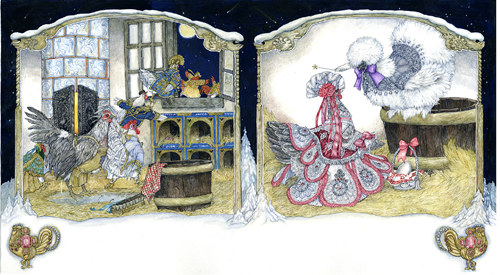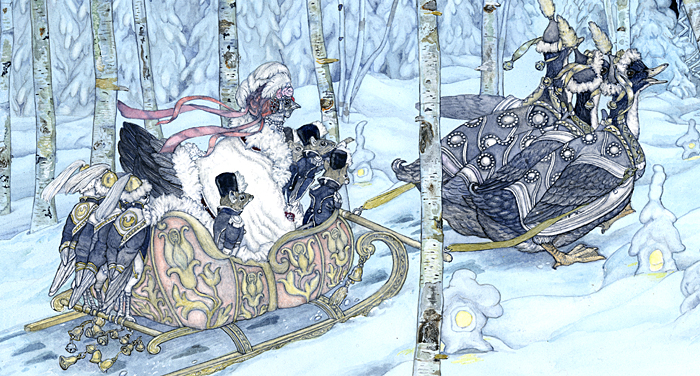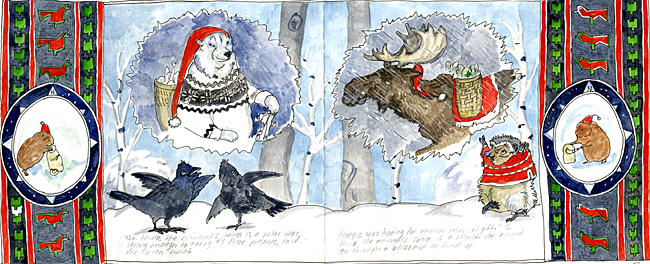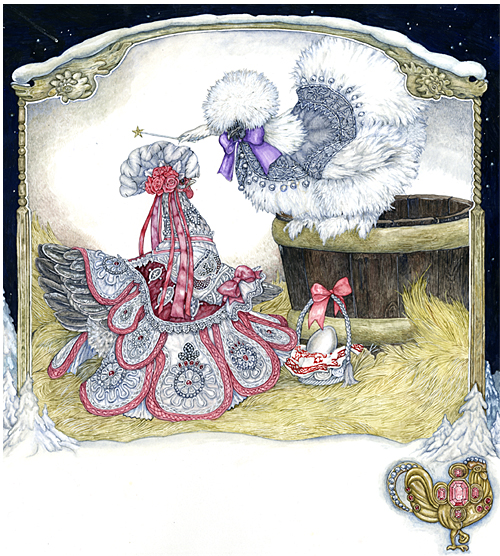May 2013 Hedge a gram
Posted by Jan Brett in Jan Brett Posts on May 13, 2013

The Fairy Godmother arrives from CINDERS, a chicken Cinderella
Happy May,
Every month, I stop what I’m doing, and let kids and interested children’s book enthusiasts know what I’m doing, in the hopes it will help you with your creative projects, or just shed some light on how I go about creating a children’s picture book.
I say “creating” because I write and illustrate my books. The artwork is what really drives my interest, and has been the part of my job that really defines me. that is why I will sometimes retell a favorite folktale or fairy tale. Last year I illustrated Cinderella. Because I find chickens both beautiful and fascinating, I made them my main characters. Chickens, when living in medium sized flock of many ages and of both genders, with plenty of room to move around have many human like behaviors. They can be loving, or form best friends, they can get jealous, or bossy. In my flock there is a great amount of flirting and male solicitation at the moment, which escalates in spring. The mothers are very protective of their babies, and are very patient with them as they teach them to eat, drink and come when called. All their personalities went into my book characters, and it was great fun to observe them, and then paint what I saw.
When I first thought about illustrating Cinderella, I was resistant because tend to I shy away from stories that use magic or a rescuer to save the character. The more I got into the story though, I thought that the transformation of the bedraggled, unhappy girl into the blooming confident women, is a rite of passage that can happen to a lot young women . When viewed in that way I liked the story more.
It?s always difficult to say goodbye to my characters when I’ve finished my book, but I always make sure I have a another book idea waiting in the wings. Actually, more than one! Often I’ve talked to my trusted editor about these book ideas, and she will give me a go ahead.Last summer on a hot steamy night, I got an idea about the wild animals Santa. Where it came from I have no idea, especially since I usually do my creative thinking in the morning when I’m fresh. I was so excited about this story idea that I wrote it all down, as if I heard it before and without giving it another thought, emailed it to my editor. She liked it! I didn’t know it then, but there would be many drafts and much thought as I would turn over that initial idea trying to make it a complete story. My editor kept insisting that I keep pushing and carve out a satisfying story, and I finally did. I would have been terribly discouraged when I first wrote my piece if I had known how much more work I had to go. That’s what editors are for, and the best ones manage to make you work hard without feeling like it was a bad story to start with. The writer or artist is always vulnerable when the ideas are just forming.I think that’s why a lot of creative people don’t like to talk about their work until its near completion.
I spent a few weeks working on my 32 page dummy, a cartoonish, sketch version of my book, and then took it to NY to talk about it with my editor, Margaret. We finalized the trim size, which is how the dimensions of a book are described. Then, both of us edited out as many words as we could, now that we had the artwork to describe events. The things that can’t be painted, like the fragrance of fir trees, the feel of frosty cold air or the jingle jangle sound of broken ice will be described in the words. I?ll try to tell as much of the story as I can in the pictures.
Yesterday I started on my first double page spread, actual size. I experimented with different shapes in the borders, and played attention to what colors would be in my palette. Since my book takes place entirely outside in the snow I thought about the animals that I would cast as the friends of the two Snowshoe Hares that are the main characters. When Margaret and I met in NY we thought long and hard about what the animals would wear. It could be their natural fur coats, it could be just sweaters like what dogs wear, or they could have costumes that look like they were from another culture, either real, or imaginary. I like the thought that my job entails important decisions like, ?what the animals will wear!?
One of the reasons I chose Snowshoe Hares as characters is because of their amazing winter coats. They are brown in summer, which makes them blend in when they have babies. Then in fall, patches of white start appearing. By the time the world is white with snow, they are too, except for their ear tips which remain black. I’ve always thought that was the most surprising thing. There is a bird, the Ptarmigan that does the same thing.Its feathers go from brown in summer to white in the winter, except for black tips on their wings.I set my book in Scandinavia so I could include a hedgehog as one of the animal friends, just because I like hedgehogs. Hedgehogs don’t live in the Americas. I also put in surprise appearances of a badger, wolf and moose, other fun animals to draw. I have to save the best until last because of the way I’ve told my story. The animals are all guessing who the Animal?s Santa is, and they are wondering who has been leaving gifts on Christmas.It turns out that its a Snowy Owl. The Snowy Owl is the largest Owl in North America, and it also lives in Polar regions across the Atlantic. Its a fearsome predator of small furry animals, but because of the magic of Christmas he is benevolent. Curiously, the color, white, of its feathers and the way the feathers are arranged on its face, make the Snowy looks like a bird-Santa. You can imagine the feathers framing its face looking like a beard.
I’m looking forward to continuing to work on the finishes of my book, my favorite part of the process. Good luck with your story ideas, and don’t ignore that seemingly strange idea that pops up from who knows where. I might just be a future book.
Happy Spring,
Jan Brett
April 2013 Hedge a gram
Posted by Jan Brett in Jan Brett Posts on April 1, 2013
Happy April!
This is my April hedge a gram. Every month I take a breath to oversee what I’m doing artistically and write about it. In the past aspiring writers and illustrators, and especially children, have been curious about the steps it takes to create a book, and these Hedge a gram’s give a little insight on how it’s going.
This year, it’s been a rocky start. One hot summer night last year for no reason, I got an idea about an animal’s Santa. I love the traditions of Christmas because we use our imaginations and fancy. I’ve always been fascinated by snowy owls and the fact that they breed in the Arctic, and many fly south in winter, particularly to Boston’s Logan airport which is about 20 miles from us. Every time we fly out of Boston, I’m glued to the window trying to pick up a teeny blob of white as we taxi. So far, I’ve never seen a snowy owl, but because of their beauty and singular faces they are photographed a lot, and I enjoy seeing the images. They have an otherworldly gaze as if from a faraway place, and their white color and black rimmed yellow eyes give them a look of sorcerers. When I wrote my first draft of THE ANIMAL’S SANTA, I had the snowy owl in mind as Santa. It is a creature of the far North that is beautiful and mysterious. It travels south every winter and its white face reminds me of a Santa, even appearing to have a smile in some photos.
The first draft didn’t have enough substance, so I spent weeks trying to cobble together a storyline which could be receptive to my original idea of the mysterious visitation of the largest owl in North America from the Arctic.
I wasn’t getting any traction writing my story, so I switched to telling the story in pictures. This is unorthodox for me, because so far all my books have begun as manuscripts. I used all my usual techniques to try to puzzle the story together. I’ve been thinking about it while running, thinking about it while listening to music, and asking myself questions before falling asleep, hoping my unconscious mind will help me out.
When I was a little girl at Wilder Memorial nursery school in Hingham, Massachusetts, where I grew up, we made native American headbands, and we were able to choose a feather to have stapled to it. I was thrilled with the prospect and was enamored of a book I had at home at the time which described different Native American tribes, their art work and clothing. My grandfather fueled the flames of my interest by taking us for walks in the woods where we tried to walk like Native Americans, making no sound that would scare the animals. Our nursery school teacher had two huge bags of white turkey feathers. One bag held white feathers that had been dyed black at the tip to look like eagle feathers. The other bag had feathers dyed rainbow colors, including unusual ones I recognized from my crayon box of 200, like chartreuse, magenta, and turquoise. I was overwhelmed with the choice. Do I choose the more authentic eagle feather, that would look like the headdress in my book, or do I choose one of the vibrant colors that please the eye? Years later, I’m still grappling with that dilemma. I’m writing a book about the animal’s Santa. Does my cast were fascinating, elaborate clothes like out of the Hobbit? Or, do the animals wear just a nod to clothes, taken from Native American items I’ve seen in the Harvard Museum’s collection. Idea number one would be colorful and charming, idea number two would be perhaps more true to the spirit of my story. I’m working on both ideas at once, and will go to New York this month to work with my editor, but I’m drifting toward the same decision I made 59 years ago at nursery school, when I chose the “eagle” feather.
Creating a children’s book remains a mysterious process, and one that has highs and lows. The rewards are worth it, and never fail to amaze me.
Good luck with your creative projects, and don’t give up on your idea!
Happy Creating, your friend,
Jan Brett
March 2013 Hedge a gram
Posted by Jan Brett in Jan Brett Posts on March 2, 2013
Happy March!
This is Jan Brett with thoughts about my books. I am primarily an illustrator, but I like to write the story myself, or retell a familiar one, so that makes me an author/illustrator.
I’ve just finished the last piece of art for CINDERS, a chicken Cinderella which will be published in September 2013. I knew there would be a lot of detail in the chickens and in the ballroom costumes, and many characters on each page, but I underestimated the time it would take, and I spent November, December, January, and much of February working long hours to complete my year long project. I usually work every day, but the flexibility I get from working at home in combination with having one big deadline a year makes it easy to get behind. I think there may be another reason it is so hard to finish a book. I get to really like my characters and the combination of the setting, in this case Russia, and characters, in this case chickens I may never have a chance to paint again in book form. It’s hard to say goodbye, and I feel myself resisting sending the last piece of art in that will end it.
Luckily I can get started on a new book, and be energized by imagining a new world and characters. I’m struggling with getting a great storyline for my 2013 book, THE ANIMAL’S SANTA. Normally I get the manuscript in working order, to be approved by my trusted editor. This time though, she has many questions, which means the story isn’t really working for her. This gets difficult, because it’s hard to retrace one’s steps, then change things but still keep the original story idea. I’m taking a different tack and using illustrations to tell the story and see if I can get it right. Then I will go back to words and checking with my editor. It’s extremely difficult to plow through negativity, but I listen to my editor because she has very good ideas and instincts. Sometimes I’ll use the trick of solving problems by asking myself to fix something before I go to sleep, turning over the idea just as I’m nodding off. I think about the story when I run too. Not on a fast run or a race but on fun runs. Sometimes, the fresh air and oxygen flow will kick off an idea. My husband is a good judge, and he can give me a lot of useful input as well. It is very hard to know how much criticism to let in, because it taints the story, and then “pouf” you have nothing.
I recently heard Lang Lang a famous pianist perform. I was in the audience and was swept away with his interpretation of Rachmaninoff’s second piano Concerto. Afterwards there was a reception when he answered questions from concertgoers at a small gathering. I didn’t ask a question, but I thought about what I would’ve asked if I was a bit quicker in thought. First, I would have to say he’s an artistic genius and that is always a fascination. My question would be how often in his creative life does he have pivotal ideas the kind that in cartoons show a lightbulb over the character’s head, or they could be called “Aha moments”, or epiphanies. I thought I’d write down a few of mine.
When I was just starting out as an illustrator, I brought my portfolio, which consisted of animals dressed up in clothes, to a publisher. The editor that looked at it said, “Children’s books are about children, why don’t you illustrate children?” I said,”They are too difficult to illustrate, they are too important and make me feel too serious.” The editor said, “Just imagine a zipper on those furry animals, and pretend there is a child underneath.” That made sense to me and I drew children after that.
Another “aha” moment was when I sketched on tracing paper with a pencil. Ideas just flowed. Why? I don’t know, but now if I get stuck I get out the tracing paper, and lay it over white paper. Something about it triggers my creative thoughts.
My editor, Margaret once suggested if I get stuck, to change the storyteller to “I”. You can write the story, then change the first person tense to one of the character’s perspectives, once the storyline is alive and well.
This is a strange one, but if I eat a sugary breakfast like pancakes with maple syrup and add fruit and a good strong cup of tea with honey and milk and sit down on a sunny day first thing in the morning, I tend to get a lot of good incoming ideas. A clean desk also helps.
Never, never tell your good story idea to anyone until you get it down on paper. The internal drive of storytelling is very delicate. If you field your story to a lot of people, and tell how you’re going to do it, it is like letting the air out of a balloon. After it’s written down and you feel it is finished, then it’s okay to get another opinion, painful as it may be.
Creativity is somewhat mysterious, but when a work of art unveils itself like when I heard Lang Lang’s concerto, it is obvious to all. As Gertrude Stein said, “A rose is a rose is a rose.”
Happy Creating, your friend,
Jan Brett
February 2013 Hedge a gram
Posted by Jan Brett in Jan Brett Posts on February 2, 2013

On the way to the ball!
Happy February!
Every month I mark the first day by gathering my thoughts about what I’m accomplishing as a children’s author and illustrator, and what’s next! I put in an exclamation point because I am full of a lot of bottled up energy about CINDERS, the book I’m just finishing, and the coming year’s book project.
I have one and 1/2 double page spreads to finish on CINDERS, plus all the corrections and continuity fixes. I work from a dummy, that I make early on in my book building process. Its in sketch form, and I leave many details for when I work on the final paintings. For example, every book has a subtle color palette. In this book I had three elements of color that I knew were going to be influential. One is the white/blue of the ice and snow. It would be in all the outside scenes, the borders, and the interiors of the Ice palace. Then, there is Cinders dress. I wanted her to be light, innocent and bride-like. She would be competing with all the other chickens in their colorful Russian finery, and I wanted her to stand out. I created a dress befitting a princess in white and pink. Then, there is the orange pumpkin. Orange is a more fiery, southern color, and when I saw white pumpkins at Halloween I thought that maybe a white pumpkin would be an option. However, it didn’t ring true when I painted the pumpkin. As a child, the part of the Cinderella story I liked best was the transformation of the mice, pumpkin and rat to coach, footman and coachman. I was especially pleased to think she could ride in a sleigh, it being set in a Russian winter. Since I wanted a connection between the sleigh and pumpkin, I knew it would have to carry the same colors especially orange. In Saint Petersburg, I was lucky enough to see some old Russian sleighs in the museum of Ethnography. So my three colors are white/blue, pink and orange. Two other colors played minor rolls, the dark blue black of the night sky, and the soft yellow of the hay in the chicken house. When the book is about half completed, we (my editor, art director, and designer, Margaret, Cecilia and Marikka) start thinking about the jacket design, probably the most important image in the book. That is when some of the colors that tell the story can be used, and they will add to personality of the book.
I think of myself as an illustrator before being an author, or more accurately, I tell my story in pictures. You can see how colors are like characters, and how I can shape characters by using color. Prince Cockerel, being royal wears purple, and I made sure he was the only character that does except Cinders on the very last page, but then, she’s a princess. At least I hope they got married! Maybe Cinderella’s wedding would be the subject for another book.
Thank you everyone for entering the contest on my website, for a school visit. I will never forget the wonderful people in Windsor, Newfoundland where I visited last spring. Next time I go, I would like to drive and go on the ferry, so I can stop and see things, and go out whale and bird watching. There is one Moose for every 4 people in Newfoundland, so I would hope to see a Moose as well. Windsor is not a large town, so don’t get discouraged about the contest if your community is not large. The website tabulates how many “likes” they have put on the Facebook page.
My husband Joe is working on a video that will show how to draw Cinders, and some of the scenes we saw in Russia and how they were transformed in my studio to become part of a chicken fairy tale. I will also have Cinders (real name Eddie, Prince Cockerel (Elof) and a few other of my poultry stars and starlets to show you. My friend Janet, who raises Silkies, is going to let me have a pair of her beautiful whites. The video should be up by April!
Happy Creating, your friend,
Jan Brett


Comments, thanks from Jan Brett